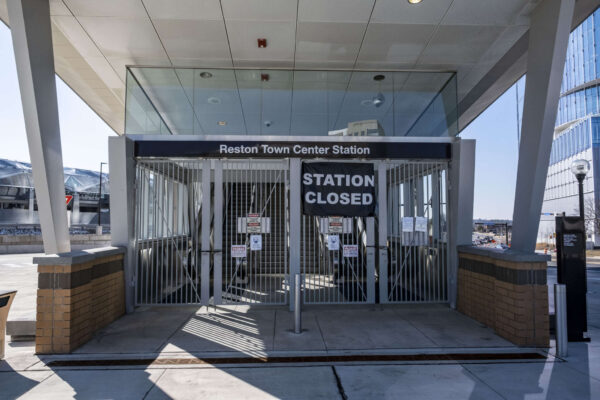
As the county officially approves paying an additional $40 million to finish the Silver Line Phase II, fare evasion continues to irk supervisors.
At yesterday’s Board of Supervisors meeting, the county followed through on the transportation committee’s recommendation last month to pay an additional $40.25 million to the Metropolitan Washington Airports Authority (MWAA) for the completion of the Silver Line Phase II.
As noted at the Sept. transportation committee meeting, the board didn’t have much choice in the matter. In July, MWAA agreed to increase the budget for the extension by $250 million which will be largely shouldered by Dulles Toll Road users. Because the original project agreement calls for Fairfax County to pay about 16% of the overage, the county owed an additional $40.25 million.
Last month, Board Chair Jeff McKay expressed his frustration about paying even more money for the much-delayed project but noted that it was a “requirement” and the county didn’t have the flexibility to not pay it “without significant negative consequences.”
At yesterday’s meeting, though, McKay struck a slightly different tone by focusing on the Silver Line Phase II’s potential to be a “game-changer” for the region.
“We can’t understate the importance of this project to the long-term success of Fairfax County,” McKay said. “It’s a major milestone.”
There remains no set date for when the line will be ready for riders, though Metro confirmed to FFXnow yesterday that it’s on track to open by Thanksgiving with the go-ahead to add more trains.
The supervisors also took a few moments at this week’s meeting to discuss Metro’s plans to stop fare evasion. Earlier this month, Metro announced it was ramping up enforcement and will be testing new station fare gates that are more difficult to jump over.
Metro estimates that fare evasion has cost the agency about $40 million this year, or nearly a quarter of its budget gap.
Several supervisors noted that they were pleased there was finally movement on better enforcement of fare evasion. Hunter Mill District Supervisor Walter Alcorn said there are certainly “equity issues” when it comes to enforcement, but “it has to be a level playing field.”
However, Dranesville District Supervisor John Foust called fare evasion the “least of [Metro’s] challenges” in terms of securing long-term funding for a system that could be facing a $500 million funding gap next year.
“They need a plan that goes way beyond [dealing] with fare evasion,” said Foust.
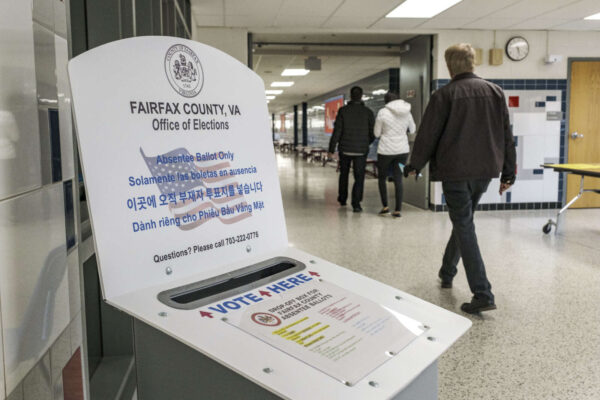
Fairfax County Board of Supervisors Chairman Jeff McKay is calling on a full investigation into an incorrect elections mailing that was sent to 25,000 voters in the towns of Herndon, Clifton and Vienna.
At a board meeting earlier today (Tuesday), the board unanimously agreed to a move by McKay to call on the county’s General Assembly delegation for an inquiry into the botched mailing. Residents were directed to an incorrect polling location in the City of Fairfax.
McKay called the issue “the worst breach of election integrity” he has seen in the county.”
Late last week, the Fairfax County Office of Elections sent letters to affected residents providing correct voter information. The Virginia Department of Elections attributed the mistake to a “printing issue.””
“In spite of our staff’s efforts to distribute accurate information as widely and as quickly as possible, they still fielded a large number of calls from voters confused by this incorrect mailing at a time that is already extremely busy as the election process is underway,” the letter states.
The letter further states that a full investigation is necessary to restore and maintain public confidence in the state’s democratic system.
“The factors that led to this mailing, as well as detailed findings of the investigation, must be publicly released, along with any recommended corrective actions, so Virginians can understand what happened and ensure that it never happens again,” the letter states.

The Fairfax County Board of Supervisors is formally opposing Gov. Glenn Youngkin’s proposed model policies that would limit the rights of transgender and other gender-nonconforming students.
In a letter approved at a board meeting today (Tuesday), board chairman Jeff McKay said that the policies would have a negative effect on the county’s economic position and cites the human impact on students. Springfield District Supervisor Pat Herrity voted against the proposal.
“Your model policies – and the discrimination inherent to them – will have a chilling effect on our continued ability to attract the world’s most innovative companies to Fairfax County. To put it bluntly, discrimination is bad for business,” the letter, which is addressed to the Virginia Department of Education, states.
Braddock District Supervisor James Walkinshaw noted that the proposal policy is contradicted by U.S. Supreme Court decisions and other legal precedent.
“Thankfully, many school system in the Commonwealth don’t intend to adopt them,” Walkinshaw said.
When voting against the proposal, Herrity questioned why the county was weighing in on a proposal related to the school system when other issues — like declining enrollment, learning loss, and the achievement gap — need exploration as well.
“My biggest problem with the letter, I don’t see any staff working on this at all,” Herrity said. He also said parents need to be involved in “critical decisions of this magnitude,” adding that parental permission to give a child an aspirin in schools.
McKay responded by stating that the board’s letter is part of the state’s education department call for public comment on the proposal — a comment period that ends tomorrow.
His letter also says that the policies put the county’s children at risk by denying support and affirmation to transgender students.
“A young LGBTQ person attempts suicide every 45 seconds in the United States. Key drivers of high rates of depression, anxiety, and suicide among transgender youth are the lack of social support and affirming experiences that they often face,” the letter states.
The proposed policies are at odds with the school system’s current policies that affirm students’ rights to accessing restrooms based on their gender identity and being called by their chosen names and pronouns. FCPS moved to update its previous policy — last amended in 2020 — based on state recommendations.
A spokesperson told FFXnow that the school system did not have more information to share about its position on the state’s policies. FCPS Superintendent Michelle Reid sent to families last month, stating that FCPS was reviewing the draft policies.
This is not the first time McKay has publicly questioned the draft policy. Earlier this month, McKay told FFXnow that the school system may have legal grounds to go against the model policies.
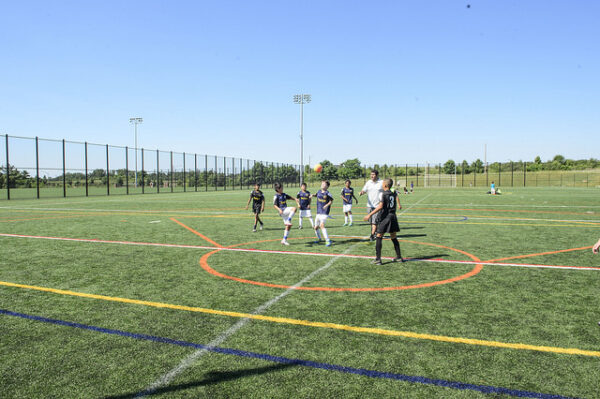
Concerns over equity and the recommendation of specific sites have delayed Fairfax County’s push into sports tourism.
At last week’s Board of Supervisors meeting, Springfield District Supervisor Pat Herrity proposed that the county start advertising that it’s seeking proposals from private entities to develop sports tourism facilities.
However, he pulled the motion when it became clear that there wasn’t enough support from other supervisors to move forward. When he made the request in May, the board voted instead to have staff reassess a consultant’s report to ensure equity is considered when evaluating future projects.
“We’ve been sitting on the sidelines far too long. It’s time for us to get in the game or not,” Herrity said. “This is something the board has clearly expressed that it would benefit both our sports community, our taxpayers, our hotelers, our restaurants, our hospitality industry. We need to move forward and stop trying to find ways not to do it.”
Board Chairman Jeff McKay argued that Herrity, in fact, had “delayed the process.”
“I want to make it crystal clear that this board supports sports tourism…What we are doing is trying clean up the fact that it wasn’t done right,” he said. “Equity was left behind.”
A consultant hired by the county released a report in August 2020 recommending how the county could “more effectively compete within the sports tourism marketplace,” including specific sites where a large facility could go in the county.
The Park Authority-backed study identified nine different sites that it said could support facilities like a rectangle field complex with 16 fields or an ice complex, comparable to the one in Ballston.
However, as several supervisors brought up, none of the sites were vetted for equity, environmental impacts, or even the land’s current ownership.
Many of the preferred sites are in the north and northwest part of the county, while none are located in the south. Several sit in protected watershed areas, while a few others are privately owned, like George Mason University property, as opposed to county-owned.
The equity review requested in May was finished over the summer. Last month, the Sports Tourism Task Force recommended proceeding with an advertisement and “to consider the equity impact review as it reviews potential public-private partnerships” instead of at this stage in the process.
This didn’t sit well with several supervisors, including McKay, who wanted to make sure that the advertisement made clear that the recommended sites in the study were not county-approved.
“Frankly, I wish the consultant report didn’t exist. I think it was created under false pretense…It had no look at equity,” said McKay. “I don’t necessarily support any sites in there…They are in no way in any shape or form an endorsed list of locations by this board.”
Herrity accepted an amendment that the ad include language urging developers to be “creative” and recommend a site not on the consultant’s list.
Additionally, McKay asked that the entire board look at the advertisement to vet the language prior to it being released.
The plan now is to have staff update the report before Herrity resubmits the motion. While he hoped to have it by the board meeting on Tuesday (Oct. 25), Herrity told FFXnow that November now looks more likely, though he “was ready six months ago.”
He said this is the first program, in his recollection, “forced” to have an equity review as well as the first time that he remembers where the board will review the language for a request for proposals.
Nonetheless, he’s ready for Fairfax County to get in the game and build facilities that could help bring more revenue to the county, particularly with increased hotel occupancy.
The rest of the board appears to agree with the idea of exploring sports tourism, but it has to be “done right.”
“We have a once-in-a-lifetime chance to get this done right that will permanently…affect the long-term sustainability of sports and sports tourism in this county,” McKay said.
Photo via Fairfax County Park Authority
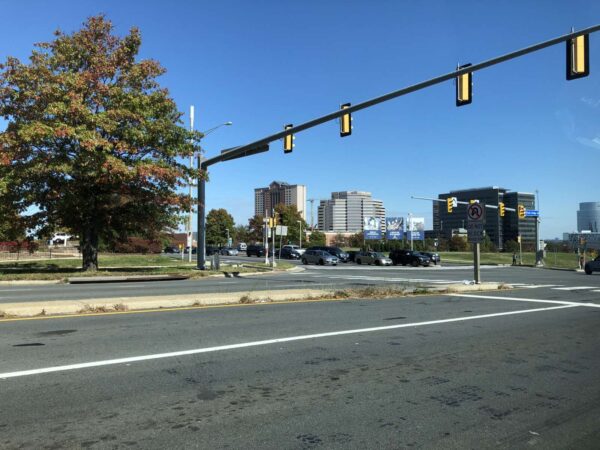
Fairfax County is once again discussing how to discourage “panhandling” while also declining — at least for the moment — to make it illegal to engage with anyone in a county-owned road or median.
The subject was revived at last week’s board meeting by Springfield District Supervisor Pat Herrity after cropping up a number of times over the last several years.
Herrity’s board matter argued that people in the road or median asking for money not only “generates considerable public complaint,” but is a safety risk for both those individuals and motorists.
“Anyone who stands in the median of our busy intersections trying to engage with motorists puts themselves in danger and presents a dangerous distraction to motorists,” Herrity’s board matter said. “This applies to panhandlers, fundraisers, marketers, and anyone else in the medians.”
However, a recent study by the county somewhat disputes this assertion. At Herrity’s urging, the board directed staff in May to conduct a study into if there are “public safety risks” in relation to people being in roads asking for money.
Sent to the board in July, the study results concluded that staff was “unable to find a significant public safety risk related to or stemming from panhandling,” mostly because that data wasn’t being collected at that level of specificity.
“While panhandling appears dangerous and generates considerable public complaint, available FCPD data does not support a determination that panhandlers are more likely to be injured or killed than other pedestrians, or that locations where panhandlers are present have an increased risk of traffic accidents,” the study said.
Nonetheless, Herrity disagreed with the assessment by saying a study shouldn’t replace “commonsense.”
While this is a step in the right direction, my colleagues would not approve my related motion that would have directed our staff to have a draft panhandling ordinance prepared for discussion in a Public Safety Committee meeting and/or Closed session.
— Supervisor Pat Herrity (@PatHerrity) October 13, 2022
“With as many tragic pedestrian fatalities as we have had in this County, including one panhandler, I am frankly appalled that we have not done more to protect our residents on this issue. We should not need a study to determine what is commonsense,” Herrity wrote in the board matter.
At the board’s Oct. 11 meeting, Herrity proposed directing staff to “draft a curb-to-curb safety ordinance that would restrict anyone from engaging with motorists between the curbs of a road with the exception of recognized public safety entities,” including for the Fairfax County Fire and Rescue Department’s annual “Fill the Boot” campaign. Read More

(Updated to correct number of affordabke units and clarify nature of funds) The Arrowbrook development near the Innovation Center Metro Station got a funding lift yesterday (Tuesday) afternoon.
The 274-unit project, an affordable housing development under the federal Low Income Housing Tax Credit program, received $3 million in funding after the Fairfax County Board of Supervisors voted to approve the issuance of bonds.
The move fills a $3 million funding gap that the county says was created by “supply change shortages resulting from COVID,” according to county documents.
Springfield District Supervisor Pat Herrity voted against the proposal.
Located at the future Arrowbrook Centre Drive and Centreville Road in Herndon, Arrowbrook is being developed by SCG Development Partners.
The project is already under construction and is more than 70% complete.
Board of Supervisors Chairman Jeff McKay touted the county’s efforts to reach its affordable housing goals.
“The work to ensure every resident of Fairfax County can live and work here is a nonstop focus of the Board. Earlier this year we doubled the County’s goal to 10,000 net affordable units by 2034, and we have 4,000 units either completed or in the pipeline. We are proud of the work we have done and continue to do with our partners, both non- and for-profit, throughout the region,” McKay wrote in a newsletter following the meeting.
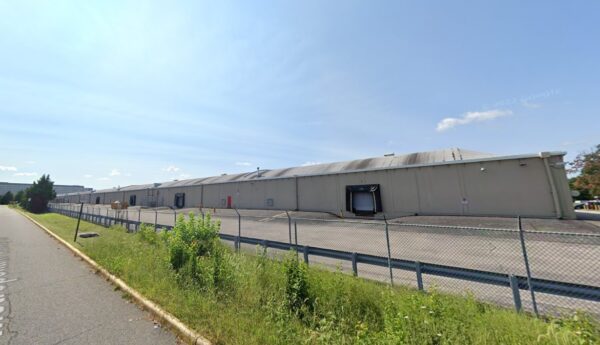
Fairfax County Board of Supervisors Chairman Jeff McKay says Springfield would be an ideal choice for a new FBI headquarters — or would be if another agency wasn’t involved in an underhanded attempt to play favorites.
While it’s not exactly shocking that the county’s top elected official thinks Fairfax would be a good choice for the new FBI headquarters, McKay has gone a few steps past that and accused Washington Metropolitan Area Transit Authority (WMATA) of putting a finger on the scales.
The Springfield site is up against two Maryland locations: one in Landover and one at Greenbelt that is owned by WMATA. Since WMATA is funded by all three jurisdictions, McKay argued that it’s unfair for Fairfax to essentially be forced to fund their competition for the lucrative FBI headquarters deal.
The feud is nearly a decade old. McKay first raised these concerns in 2013 and repeated them in a letter last month. He urged the WMATA board not to consider the Greenbelt Joint Development Approvals plan, which would authorize Metro to make negotiations about the sale of the site with government entities, WUSA9 reported.
The Springfield site is currently home to a warehouse complex owned by the General Services Administration, which is in charge of the site selection process. The warehouse would need to be torn down before the FBI headquarters could be built.
Still, McKay said the site has easy access to several major highways and a direct link to the FBI Academy at Quantico.
“The Springfield site is owned by the federal government and has all the infrastructure, either in place or pledged, to support the relocation of the FBI headquarters,” McKay said in a statement to FFXnow. “It has easy access to Interstates 95, 395, and 495, provides a direct link to Quantico on the VRE, has ample bus lines that stop onsite, and also has a Metro stop. It’s a no-brainer for the FBI and the GSA to choose Springfield for the next FBI headquarters.”
The GSA announced in late September that the new site will be determined by a three-person panel with two of its employees and one FBI representative. The panel will prioritize the site’s suitability to the FBI’s mission and transportation access, but cost, equity, and flexibility will also be considered.
Image via Google Maps

A major rewrite of Reston’s central planning document — the Reston Comprehensive Plan — could take additional time for review due to pending legal issues and concerns flagged by the Fairfax County Board of Supervisors.
At the board’s land use policy meeting last week, county staff noted that the update to the plan — which was led by a 31-member task force over the last two years — contains language that is at odds with some countywide policies. The county’s attorneys office is reviewing the draft, which was written by the task force, for legal issues.
The ongoing review is expected to delay the approval process — which previously docketed for Nov. 2 before the Fairfax County Planning Commission.
Public comment on the plan is ongoing. The task force approved draft recommendations on Aug. 28 after 58 public meetings. Hunter Mill District Supervisor Walter Alcorn convened the task force after he took office in 2020.
While lauding the overall effort led by Alcorn and the community, some board members characterized the update as ambitious or overtly prescriptive.
Rather than broadly limiting, restricting or expanding development, the plan makes site-specific changes to a limited number of areas. It also includes specific chapters dedicated to equity and community health.
The recommendations are intended to bring Reston — which is navigating the tension and opportunity of growth in transit-oriented areas and old development — into a new era.
“I am concerned that this may fail by its sheer weight,” Mason District Supervisor Gross said, observing that the draft appears to lean toward creating space for more William-Sonomas, a candle shop, than Dollar Stores.
Board of Supervisors Chairman Jeff McKay said it’s important to recognize the plan is not the first in the county with a chapter dedicated to equity as a planning tool. The county’s One Fairfax racial and social equity policy, adopted in 2019, applies to the entire county.
“The last thing we want to do is confuse people that that’s not a standard,” McKay said.
Others questioned the decision to give the task force the authority to draft the plan instead of staff.
In a statement to FFXnow, Alcorn defended the approach, which he said is characteristic in community planning:
This is not new. Ever since the scandals of the 1960s (note these were referenced recently in a Fairfax County Times article on Edwin Henderson II) Fairfax County has practiced community-based planning where community task forces have been “given the pen” to ensure the direction and vision of the comprehensive plan reflects the will of the community. In my 16 years on the Fairfax County Planning Commission Mt. Vernon Commissioner and Planning Commission Vice-Chair John Beyers regularly referred to the comprehensive plan as “the people’s plan.”
This practice is noted in the 2011 Burnham Award from the American Planning Association when the Tysons plan was recognized as the best top comprehensive plan in the country. As for the recent Reston process, it is also true that much of the task force recommendation was drafted by County staff – frankly to the disappointment of some task force members. The task force recommendations include new proposed guidance on quality of life issues like equity and community health, and I look forward to continued community feedback and ultimately a recommendation from the planning commission that reflects the values that make Reston a special place.
Comparing the comprehensive plan amendment process to Seven Corners, Gross questioned why the task force led the writing when staff with professional expertise in policy writing and planning could have initiated the process with significant task-force and community input.
Franconia District Supervisor Rodney Lusk encouraged staff and the board to use the “excellent” work by the task force as a foundation for the final update.
“Let’s think about this as an opportunity to use this excellent work as a way to be a foundation for the future changes that we could make,” Lusk said.
Now, county staff are leading a comprehensive effort to review the document — which has already piqued several issues.
Chris Caperton, deputy director of the county’s department of planning and development, said the plan includes “a lot of aspirational language” that appears to be “heavy-handed.”
McKay concluded that staff and board comments indicate that more time is needed for review.
“I think what’s clear here is this is going to take a while,” he said.
Springfield District Supervisor Pat Herrity encouraged staff to iron out the legalities of what developers should, could and are simply encouraged to do in Reston.
“The conflicts also make it more complicated for developers, ” Herrity said, adding that Reston is a critical economic corridor.
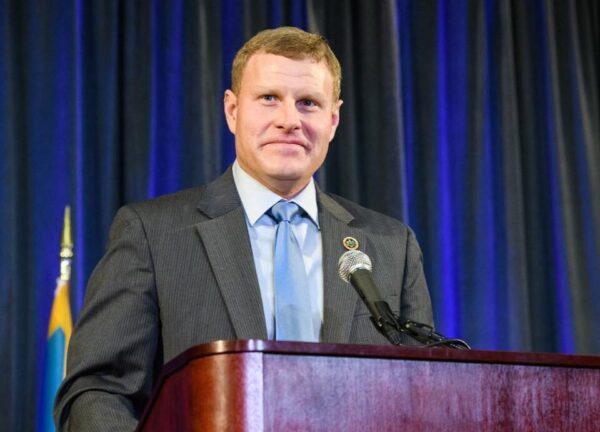
Fairfax County deserves more local authority, Board of Supervisors Chairman Jeff McKay says, calling Virginia’s Dillon Rule “increasingly more intrusive” in day-to-day operations.
The Dillon Rule dictates that localities only have the authority to create laws, set guidelines, and wield power if the state expressly grants it to them.
However, McKay argues this system treats counties as so “unsophisticated” that they need the state to make decisions for them — an assumption that seems particularly outdated for a locality like Fairfax County, which is home to nearly 1.2 million people and an annual budget of $4.7 billion.
“It’s a…broken, inconsistent, and non-responsive system for our constituents that needs modernization,” McKay told FFXnow. “Every time we need something, we’ve got to go to Richmond and beg because most [Virginia] localities don’t need or want that authority. And that’s a problem.”
McKay told Axios D.C. last month that he wanted the county to have more control over its destiny, including the option to levy personal income taxes.
He calculated that Fairfax County only gets 23 cents for each dollar it pays in state taxes. While some disputed that exact calculation, McKay says the county sends enough revenue to the state that it should have more authority to determine how it’s generated.
“I think the county should have the authority to levy any tax that they want and let their voters hold them accountable,” he said. “The state should not be telling them, ‘You can’t raise revenue this way or that way or any other way.'”
If allowed to do this, he would consider a personal income tax as a means to lower — or, even, eliminate — the real estate tax, which provides over $3 billion, or roughly 68% of the county’s annual revenue. He says it would be a fairer, more equitable, and less risky way of raising revenue.
The Dillon Rule’s restrictions on local authority go beyond taxes, hampering day-to-day operations of the county, McKay says, arguing that the “one-size-fits-all” mentality of governing no longer works in a state where counties are diverse in size, population, and budgets.
For instance, rewinding to 2020, McKay says he and other Northern Virginia leaders had to “compel” then-governor Ralph Northam to delay rolling back Covid restrictions in the region.
At the time, Fairfax County’s infection numbers were a lot closer to those in D.C. and Montgomery County than to Roanoke or smaller Virginia localities. Yet, while D.C. and suburban Maryland could keep their covid restrictions in place, Northern Virginia was initially on the same timeline as the rest of the Commonwealth.
“I didn’t have the same authority that they had to do what they were doing,” McKay said. “I was beholden to negotiating, in essence, with the governor about what was in the best interest of Fairfax County.”
McKay says the Dillon Rule is also a factor in the case of the Glasgow Middle School counselor who was arrested last year for a sex crime but stayed employed by Fairfax County Public Schools for months after.
“Another example of a challenge in my community that…fell through the cracks because of a lack of detail, lack of aggressiveness, and lack of awareness of what the Virginia standard or requirements are for localities reporting these incidents,” he said. Read More

(Updated at 4:05 p.m.) Fairfax County is looking to charge up a new electric vehicle charging station program and pilot it in Reston.
At last week’s Transportation Committee meeting, the Board of Supervisors discussed a new “Charge Up Fairfax” program, where the county would provide support to homeowners’ associations (HOAs) and multi-family communities to install electric vehicle (EV) charging stations in common areas.
“Electric vehicles are coming and a large segment of the population won’t be able to participate simply because of the issue of at-home charging,” Office of Environmental and Energy Coordination Director Kambiz Agazi said Friday (Sept. 30).
The county hopes that, by 2030, 15% of all light-duty vehicle registrations in the county will be EVs, per the Community-wide Energy and Climate Action Plan (CECAP) adopted last year. By 2050, the aim is to be at 42%. As of May 2022, though, under 1% of light-duty vehicle registrations are electric.
Under the proposed pilot program, the county would work with HOAs, large multi-family apartment buildings, and condo associations to install EV charging stations in publicly available locations, such as parking garages and designated parking spots owned by an HOA.
The county has proposed starting the pilot with Reston Association (RA), the largest HOA in the county and possibly the country. (Correction: This article initially said Reston Association has been chosen for the pilot. RA says conversations are underway, but no final decision has been made.)
Agazi said the pilot program is funded, but a timeline wasn’t established at the meeting.
There are more than 1,500 home, apartment and condo associations in the county, according to Hunter Mill District Supervisor Walter Alcorn.
“We are kind of at the forefront on this one and there not a lot of communities in the region, or even around the country, that are trying to tackle this,” Alcorn said. “We are really talking about roughly half of our population that live in communities like I do that don’t have a [private] garage or a private space that they could put a charger. So, this is a big deal.”
“Charge Up Fairfax” would assist HOAs in identifying locations for charging stations, provide technical support to set them up, and offer financial assistance. The grants would be structured to reimburse communities for a third of eligible expenses up to $5,000.
So-called “disadvantaged” communities would be able to apply for two grants, meaning they would have eligible expenses reimbursed for up to $10,000.
A big component will be a feasibility study, which the county will conduct for the HOAs. The study will consider power sources, the parking situation, community input, and other factors to determine where the best locations would be for charging stations. Read More

